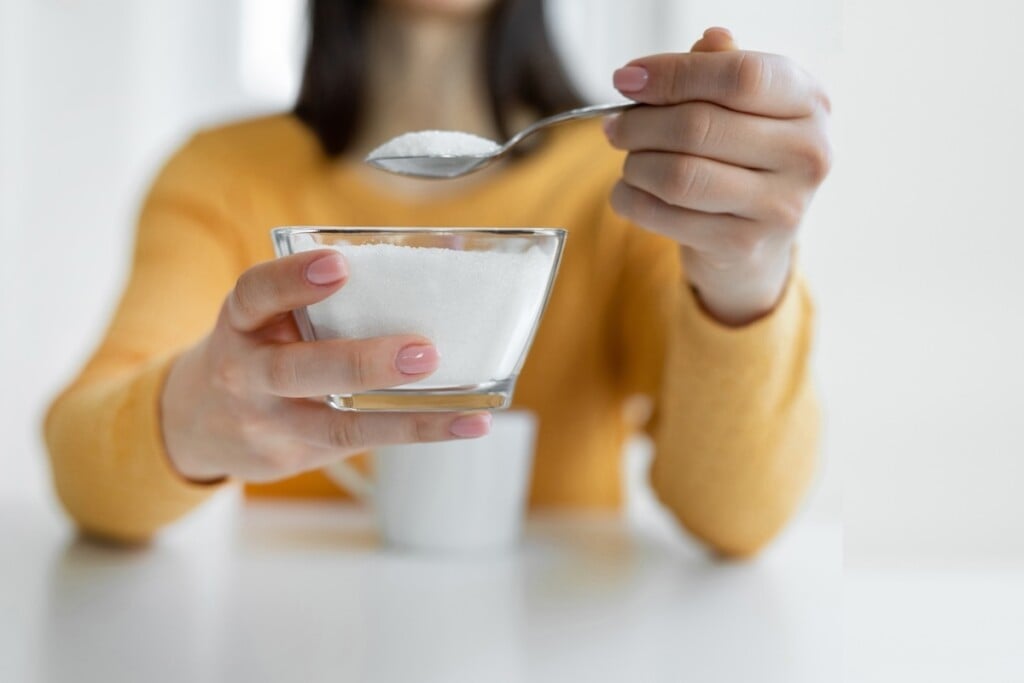How Sweet It Is
Sugar is tasty, tempting—and potential trouble. Two Bergen dietitians explain when to tell yourself “no.”

Here come the holidays, the season of piled-high dessert tables, when temptation is all around us. Sugary treats abound at parties and in celebratory breakfasts, lunches and dinners, while scrumptious goodie or candy trays may sit out all day, calling to us. The American Heart Association says Americans eat two to three times the recommended amount of sugar in a year, and this season surely accounts for more than its share.
So first, the cautionary news. “Consuming too much added sugar can be bad for your health and can raise your risk for weight gain,” says Barbara Kosa, a registered dietitian at Bergen New Bridge Medical Center. “Your body may not produce enough insulin to break it down, so it stores the sugar as fat.” The added weight from that fat increases your risk of developing heart disease, some cancers and type 2 diabetes. Kosa adds: “Excess sugar can also damage blood vessels, overload the liver and increase the risk of heart disease. In addition, the more added sugars you consume, the more likely you are to develop insulin resistance, because your body must work harder to produce insulin, metabolize glucose and maintain healthy blood-sugar levels.”
Must we turn, then, into monastic self-deniers, constantly shaking our heads from side to side until Valentine’s Day with its chocolates safely behind us? Not quite. “Consuming foods with sugar and/or sugar substitutes can certainly fit into a healthy eating plan if it’s in moderation,” says Nani Lepicard, a registered dietitian and certified diabetes educator at The Valley Hospital.
Then there’s the key distinction implied in Kosa’s warning about “added” sugar. Says Lepicard: “There’s also sugar in fruit, dairy products and starchy vegetables, and those foods offer nutritional benefits you need, such as fiber and antioxidants.”
“Sugar isn’t inherently bad,” Kosa explains. “Our bodies run on sugar. It is what carbohydrates are broken down into for energy. There is a big difference between added sugar—in foods such as baked goods, beverages, candy and even condiments—and naturally occurring sugars in fruits, dairy and complex carbohydrates.”
So what’s the best way to manage your sweet tooth? BERGEN asked our diet experts five questions:
“Will swapping out sugar for natural sweeteners help?” A quick Google search for “healthy dessert recipes” brings up thousands of hits for treats that replace white sugar with something like agave, honey or maple syrup. Alas, says Lepicard, “at the end of the day, sugar is sugar. Our bodies recognize it as such. Too much of those substitutes will also raise your blood-sugar levels.”
What these natural sweeteners can do, however, is give you some nutritional benefit where white sugar has none, according to Kosa. “Raw honey and maple syrup can contain antioxidants and minerals like iron, zinc, calcium and potassium,” she says. “Whole fruit and fruit juice have fiber, vitamins and antioxidants.”
Are artificial sweeteners the solution? “Sugar substitutes taste sweet, but don’t contain sugar,” says Kosa. “They have fewer calories than sugar; some have no calories at all. Most artificial sweeteners, also called nonnutritive sweeteners, are created from chemicals in a lab.” These sweeteners are ideal for those who need to monitor their blood glucose levels. Kosa also describes “novel sweeteners,” a relatively new category that is sometimes called “plant-derived, noncaloric sweeteners.” “They provide many of the benefits of both artificial and natural sweeteners, such as those in fruit or honey,” says Kosa. “Novel sweeteners are not a significant source of calories or sugar, and they’re also typically less processed.” Stevia is one example—it’s made from the Stevia rebaudiana plant, found in South America. Other examples are allulose (a commercially processed version of a naturally occurring sugar) and monk fruit, a small, gourd-like fruit found in Southeast Asia.
Lepicard, however, cautions that too much of these sugar substitutes can actually lead to a heightened craving for sweets. In addition, “There is also a correlation between these sweeteners and some adverse health effects—headaches, for example,” she says.
Kosa also acknowledges that some experts link artificial sweeteners to health hazards such as weight gain and cancer, but stresses that “studies are ongoing” and that “studies on people, as opposed to animals, have shown these products to be generally safe, so long as the acceptable daily intake for each is not exceeded.” Those limits, different for different sweeteners, can be found on the FDA’s website. For instance, the recommended daily maximum intake of aspartame, the sweetener in many diet sodas, is 50 milligrams per kilogram of body weight per day. (A kilogram is a little over 2.2 pounds.)
Can sugar get you hooked? “Sugar itself is not proven to be addictive,” says Kosa. But that may be a technicality. “Sugar does trigger the release of dopamine, the ‘feel-good’ hormone, which causes a sense of pleasure—and then a motivation to continue searching for that same reward,” she adds.
Lepicard agrees. “I see it in patients’ feedback, she says. “People can really get reliant on that rush and endorphins from eating sugar, and every time they need a pick-me-up, they start looking for a sugar fix.”
What are the danger signs that you’re consuming too much sugar? Keep an eye out, Kosa advises, for increased hunger and weight gain, as well as “mood swings, low energy, bloating/upset stomach, skin breakouts, high blood pressure, irritability and sluggishness.” Regular blood tests with your primary care doctor are also a must.
So what’s the plan for the holidays? Above all, both experts stress the importance of awareness and moderation when regulating your daily sugar intake. Make sure you know when you are consuming large amounts of sugar. Lepicard cites “sugary coffees and smoothies” in particular as items in which people may consume excessive sugar without realizing it. And Kosa adds that “Many foods labeled as ‘healthy’ actually have a lot of added sugar, like granola or energy bars. Make sure you read nutrition facts.”
If you feel yourself getting a sugar craving, Lepicard suggests trying to wait 20 minutes to see if that craving will pass, or trying to satisfy it with something such as fresh fruit or an unsweetened drink.
Lowering your sugar intake on a day-to-day basis will also make possible more guilt-free eating when you do decide to indulge, if you’re still eyeing that dessert table. As Lepicard says, “It makes life more enjoyable to allow yourself a treat now and then. Looking forward to that occasional indulgence can do a lot. That’s a part of living, and can absolutely be incorporated into a healthy eating meal plan.”

